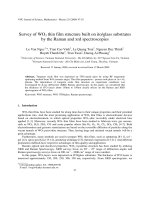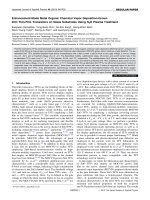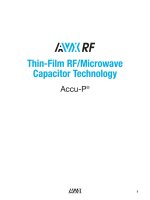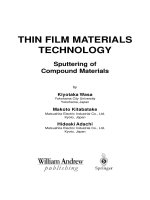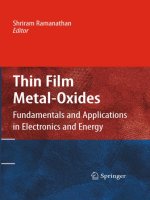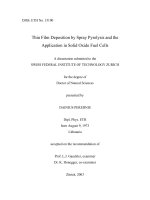thin film metal-oxides
Bạn đang xem bản rút gọn của tài liệu. Xem và tải ngay bản đầy đủ của tài liệu tại đây (9.7 MB, 344 trang )
Thin Film Metal-Oxides
Shriram Ramanathan
Editor
Thin Film Metal-Oxides
Fundamentals and Applications in Electronics
and Energy
123
Editor
Shriram Ramanathan
Harvard University
School of Engineering & Applied Sciences
29 Oxford St.
Cambridge MA 02138
Perice Hall
USA
ISBN 978-1-4419-0663-2 e-ISBN 978-1-4419-0664-9
DOI 10.1007/978-1-4419-0664-9
Springer New York Dordrecht Heidelberg London
Library of Congress Control Number: 2009941699
c
Springer Science+Business Media, LLC 2010
All rights reserved. This work may not be translated or copied in whole or in part without the written
permission of the publisher (Springer Science+Business Media, LLC, 233 Spring Street, New York,
NY 10013, USA), except for brief excerpts in connection with reviews or scholarly analysis. Use in
connection with any form of information storage and retrieval, electronic adaptation, computer software,
or by similar or dissimilar methodology now known or hereafter developed is forbidden.
The use in this publication of trade names, trademarks, service marks, and similar terms, even if they are
not identified as such, is not to be taken as an expression of opinion as to whether or not they are subject
to proprietary rights.
Printed on acid-free paper
Springer is part of Springer Science+Business Media (www.springer.com)
Stoichiometry in Thin Film Oxides –
A Foreword
The present book edited by Shiram Ramanathan kills various but at least three birds
with one stone.
1. It reveals the importance of oxidic materials for a variety of modern applications
in solid state electronics and solid state ionics in view of energy research and
information technology.
2. It highlights the significance of electronic and ionic defects and their coupling
through stoichiometry. Ionic point defects are relevant in two ways: At room
temperature they are typically frozen and act as dopants. At high temperatures
they are mobile, a property that is used in electrochemical devices. The latter
point is important for room-temperature applications, too, as the stoichiometry
can be tuned at high temperatures and then frozen. The same point, however,
does not only provide a new practical degree of freedom, but it also can, on a
long time scale, give rise to stoichiometric polarization and degradation.
3. This contribution devoted to thin films addresses the crucial role of interfaces not
only for pathway reduction but also as far as variation of charge carrier concen-
trations and mobilities is concerned. The thickness of the layers, i.e., the spacing
of the interfaces is not just important for regulating the proportion of interfacial
effects, extreme thickness reduction can also lead to mesoscopic phenomena as
it is to the fore in the fields of nanoionics and nanoelectronics.
Let us, as an introduction to what is presented by the distinguished experts in this
book, briefly consider, on a qualitative level, the influence of the most decisive con-
trol parameters on charge carrier concentration. (Note that the ionic and electronic
charge carriers are not just important for electrical or electrochemical properties,
they are also reflecting the internal redox and acid base chemistry and are thus cru-
cial for reactivity.)
For simplicity we refer to a binary oxide M
2C
O
2
in which only the oxygen sub-
lattice exhibits disorder. As intrinsic disorder processes we have to face (1) electron
transfer from the valence to the conduction band forming excess electrons and holes
(for main group oxides this typical refers to a charge transfer from oxygen orbitals
to metal orbitals, i.e., from O
2
to M
2C
/, as well as ion transfer from regular sites to
v
vi Stoichiometry in Thin Film Oxides – A Foreword
Fig. 1 Ionic disorder (top) and electronic disorder (bottom) in a thin film displayed as (free)
energy-level diagram. The (free) energy levels are standard electrochemical potentials ( Q
ı
/ of
excess or missing particles. Unlike the standard potentials the full electrochemical potential (Q/ of
ions or electrons contains configurational entropy. The distance to the upper and lower levels is (in-
verse) measure of the respective carrier concentrations. The difference between the electrochemical
potentials themselves (note the necessary factor of 2 as O corresponds to O
2
–2e
/ reflects the
chemical potential of neutral oxygen. For bulk properties the flat middle part of the energy levels is
relevant. The level bendings at the l.h.s. and r.h.s. are due to interfacial space charge effects (here
symmetrical boundary conditions are assumed)
interstitial sites forming excess oxygen ions and oxygen ion vacancies (see Fig. 1).
In the following, let us consider the decisive parameters that influence the charge
carrier concentrations and the stoichiometry in a given oxide.
Influence of Temperature
As temperature increases, disorder is favored. Let us concentrate on the ionic dis-
order first. A typical scenario is as follows: At low T the defect concentrations are
small and the defects at random (gaps in Fig. 1) are more easily crossed. Further
increase of temperature and hence increase of interstitial and vacancy concentra-
tion leads to attractive interactions that effectively lower the ionic gap in Fig. 1,now
increasing the defect concentrations even more and eventually leading to a phase
transformation into a superionic state. Normally, the crystal structure does not tol-
erate this state and melting occurs prior to this.
The electronic analog is creating electron and holes through increased tem-
perature. Similar to the ionic picture, excitonic interaction can lead to band gap
Stoichiometry in Thin Film Oxides – A Foreword vii
narrowing and perhaps eventually to a metallic state. Often neither the ionic picture
nor the electronic picture predominates, rather the case of a mixed conductor is met,
where one meets ionic and electronic carriers in comparable concentrations. Here
trapping of ionic and electronic defects can be substantial leading to only partially
ionized or even neutral defects at low temperatures.
Influence of Oxygen Partial Pressure
For our pure material MO, at constant total pressure and temperature there is, as
far as complete chemical equilibrium is concerned, one more degree of freedom the
disposition of which fixes the stoichiometry. This degree of freedom is exhausted
if we define the oxygen partial pressure (implicitly contained in the chemical po-
tential of oxygen in Fig. 1). Even though affecting the total masses and energies
only marginally, the effect of P
O
2
variation which allows traversing the phase width
is of first order on the electronic and ionic charge carriers. P
O
2
increase augments
oxygen interstitial concentration and hole concentration (note that O formally corre-
sponds to O
2
plus two holes) and decreases the concentrations of oxygen vacancies
and conduction electrons. These variations are typically orders of magnitude vari-
ations. Phase stability provided, the conductivity typically changes from n-type to
p-type potentially via a regime of mixed conductivity or even predominant ionic
conductivity.
Influence of Doping Content
Consideration of frozen-in defects allows for further degrees of freedom; this is
addressed in this and the following paragraphs.
Implementing immobile impurities, by (homogeneous)doping, is a most efficient
and established way to modify electronic and ionic properties. For not too complex
a defect chemistry of a given system, it is straightforward to predict the effect of
a given dopant for dilute concentrations: If the effective charge of the dopant is
positive (negative) then the concentrations of all the positively (negatively) charged
defects are depressed and that of all negatively (positively) charged defect increased.
The less trivial aspect here is that this holds individually for any carrier.
Frozen-in Native Defects
Also native defects can be considered as dopants if immobile. As already mentioned
in the beginning, the connection between the high temperature defect chemistry
where these defects are mobile and the frozen-in situation is essential. A simple but
viii Stoichiometry in Thin Film Oxides – A Foreword
important point refers to the establishment of a profile-free situation. Already this
requires knowledge of the kinetics. Let us suppose the kinetics to be diffusion con-
trolled and the effective (chemical) diffusion coefficient to be known as a function of
temperature. Then one has to select an annealing temperature at which equilibration
takes as long as one can afford to wait (e.g., 1 week). If then the sample is quenched
(e.g., within 1 min), one can neglect the profiles. Were the temperature higher, dif-
fusion would still occur during quenching; were the temperature lower there would
not have been complete equilibrium to freeze in.
Interfacial Effects
A fascinating area concerns the spatial redistribution of defects, i.e., not just elec-
trons and holes but also ionic defects, such as interstitials and vacancies in the
vicinity of higher-dimensional defects. Here enormous concentration variations can
occur that – given a high enough density – in thin films do and in composites (non-
trivial percolation) may result in huge effects on overall transport properties. Ion
conductivities can be greatly enhanced by admixing even insulating particles (“het-
erogeneous doping”), in this way also the type of ion conductivity (from interstitial
to vacancy or even from anionic to cationic) can be varied. Even more strikingly:
the overall conductivity can be varied from ionic to electronic by particle size re-
duction. As to the concentration changes of all the individual carriers, one again just
needs to know the charge of the higher-dimensional “dopant,” here the charge of the
interface. If the interfacial excess charge is positive then all the positively charged
carriers such as oxygen vacancies and holes are depleted, while the concentrations
of the conduction electrons and of the oxygen interstitial are increased. In Fig. 1,
a thin film with symmetrical boundaries is assumed. (The sign of the bending cor-
responds to a concentration enhancement of oxygen vacancies and electron holes.)
While this is straightforward, clarifying the reason for the excess charge density or
even controlling it is challenging. Also synergistic storage phenomena can be met
at interfaces that are based on charge separation. Charge carrier concentrations may
also be influenced by elastic effects. Curvature effects do not play a role if we con-
sider thin films (note, however, the significance for the crystallites in the case of
nanocrystalline films), but strain effects do.
Mesoscopic Effects
While mesoscopic effects are well known for electronics characterizing the well
established field of nanoelectronics, true size effects also occur as regards ion con-
ductivity. Concentrating on the latter (“nanoionics”) means dealing with overlap of
accumulation or depletion space charge layers (flat part in Fig. 1 disappears) (lead-
ing in the extreme to artificial crystals) as well as with mesoscopic heterogeneous
Stoichiometry in Thin Film Oxides – A Foreword ix
storage forming the bridge between electrostatic capacitor and battery storage.
Confinement of ionic carriers leading to variation of local formation free energies
(then the ionic and electronic bendings can be very different) or statistical fluctua-
tions are two elements of a much larger list.
Focusing on concentration effects should not lead to the assumption that effects
on mobilities are marginal. Yet they are quite specific to the individual situation.
In addition, all these situations described also lead to equally fascinating kinetic
effects. Yet the just given compilation may already suffice to arouse interest in what
is to be described in the following chapters.
Stuttgart, Germany Joachim Maier
Preface
Metal oxides are an important class of materials: from both scientific and techno-
logical perspectives they present interesting opportunities for research. Thin films
are particularly attractive owing to their relevance in devices and also for the abil-
ity to pursue structure–property relations studies using controlled microstructures.
The inherent compositional complexity (due to the presence of ionic species) leads
to rich set of properties, while in several cases, coupling of structural complex-
ity with dynamic electronic properties leads to unexpected interfacial phenomena.
Oxide semiconductors are gaining interest as new materials that may challenge the
supremacy of silicon. A further recent area of research is in understanding interfaces
in oxides and how they influence carrier transport. Thin film oxides are extensively
used to probe strong electronic correlations.
While the book does not attempt to cover every single aspect of oxides research,
it does aim to present discussions on selected topics that are both representative and
possibly of technological interest. Ranging from synthesis, in-situ characterization
to properties such as electronic and ionic conduction, catalysis is discussed. Theo-
retical treatments of select topics as well as relevance to emerging electronic devices
and energy conversion are highlighted.
We expect the book to be of interest to scientists and technologists working
broadly in the field of metal oxides. I would like to acknowledge the authors for their
timely contributions and the Springer editorial team for their patience and valuable
suggestions.
Cambridge, MA Shriram Ramanathan
xi
Contents
1 In Situ Synchrotron Characterization of Complex Oxide
Heterostructures 1
Tim T. Fister and Dillon D. Fong
2 Metal-Insulator Transition in Thin Film Vanadium
Dioxide 51
Dmitry Ruzmetov and Shriram Ramanathan
3 Novel Magnetic Oxide Thin Films 95
Jiwei Lu, Kevin G. West, and Stuart A. Wolf
4 Bipolar Resistive Switching in Oxides for Memory
Applications 131
Rainer Bruchhaus and Rainer Waser
5 Complex Oxide Schottky Junctions 169
Yasuyuki Hikita and Harold Y. Hwang
6 Theory of Ferroelectricity and Size Effects in Thin Films 205
Umesh V. Waghmare
7High-T
c
Superconducting Thin- and Thick-Film–Based
Coated Conductors for Energy Applications 233
C. Cantoni and A. Goyal
8 Mesostructured Thin Film Oxides 255
Galen D. Stucky and Michael H. Bartl
9 Applications of Thin Film Oxides in Catalysis 281
Su Ying Quek and Efthimios Kaxiras
xiii
xiv Contents
10 Design of Heterogeneous Catalysts and the Application
to the Oxygen Reduction Reaction 303
Timothy P. Holme, Hong Huang, and Fritz B. Prinz
Index 329
Contributors
Michael H. Bartl Department of Chemistry and Department of Physics,
University of Utah, Salt Lake City, UT, USA
Rainer Bruchhaus Forschungszentrum Juelich, Institute of Solid State Research,
Juelich, Germany
Claudia Cantoni Oak Ridge National Laboratory, Oak Ridge, TN, USA
Tim T. Fister Materials Science Division, Argonne National Laboratory, Argonne,
IL, USA
Dillon D. Fong Materials Science Division, Argonne National Laboratory,
Argonne, IL, USA
Amit Goyal Oak Ridge National Laboratory, Oak Ridge, TN, USA
Yasuyuki Hikita Department of Advanced Materials Science, Graduate School
of Frontier Sciences, University of Tokyo, Tokyo, Japan
Timothy P. Holme Mechanical Engineering Department, Stanford University,
Stanford, CA, USA
Hong Huang Department of Mechanical and Materials Engineering, Wright State
University, Dayton, OH, USA
Harold Y. Hwang Department of Advanced Materials Science, Graduate School
of Frontier Sciences, University of Tokyo, Tokyo, Japan
Efthimios Kaxiras Department of Physics, School of Engineering and Applied
Sciences, Harvard University, Cambridge, MA, USA
Jiwei Lu Department of Materials Science and Engineering, University
of Virginia, Charlottesville, VA, USA
Fritz B. Prinz Mechanical Engineering Department, Stanford University,
Stanford, CA, USA
Su Ying Quek School of Engineering and Applied Sciences, Harvard University,
Cambridge, MA, USA
xv
xvi Contributors
Shriram Ramanathan School of Engineering and Applied Sciences, Harvard
University, Cambridge, MA, USA
Dmitry Ruzmetov School of Engineering and Applied Sciences, Harvard
University, Cambridge, MA, USA
Galen D. Stucky Department of Chemistry and Biochemistry and Materials,
University of California, Santa Barbara, Santa Barbara, CA, USA
Umesh V. Waghmare Theoretical Sciences Unit, Jawaharlal Nehru Centre
for Advanced Scientific Research, Jakkur, Bangalore, India
Rainer Waser Forschungszentrum Juelich, Institute of Solid State Research,
Juelich, Germany
Kevin G. West Department of Materials Science and Engineering, University
of Virginia, Charlottesville, VA, USA
Stuart A. Wolf Department of Materials Science and Engineering, University
of Virginia, Charlottesville, VA, USA
Chapter 1
In Situ Synchrotron Characterization
of Complex Oxide Heterostructures
Tim T. Fister and Dillon D. Fong
Abstract This chapter surveys the high temperature and oxygen partial pressure
behavior of complex oxide heterostructures as determined by in situ synchrotron
X-ray methods. We consider both growth and post-growth behavior, emphasizing
the observation of structural and interfacial defects relevant to the size-dependent
properties seen in these systems.
1.1 Introduction
Complex oxides display a remarkable range of materials properties: some are
insulating and ferroelectric while others demonstrate colossal magnetoresistance
or high-temperature superconductivity. In these multifunctional materials, charge,
spin, and orbital degrees of freedom couple with dynamical lattice effects, present-
ing a rich playground for both fundamental and applied research. Excitement in
this field has continued to build following the recent discoveries of novel phenom-
ena exhibited by atomically tailored oxide heterostructures [1]. Symmetry breaking
and charge transfer across an oxide interface can lead to emergent properties – e.g.,
superconducting interfaces between insulating oxides [2] – while epitaxial strain al-
lows for the production of new structural phases or electronic ground states [3, 4].
Poor control over oxide synthesis, however, can result in irreproducibility and con-
tribute to significant discrepancies in the scientific literature.
As many of these novel properties are strongly dependent on stoichiometry
and finite size effects, strict control over film composition and thickness is essen-
tial. Common growth techniques include molecular beam epitaxy (MBE), pulsed
laser deposition (PLD), and metalorganic chemical vapor deposition (MOCVD).
With such deposition methods, it is possible to achieve reasonable stoichiometric
and excellent thickness control. Growth takes place far from equilibrium, however,
meaning that the kinetics of deposition and oxygen incorporation can strongly in-
T.T. Fister (
) and D.D. Fong (
)
Argonne National Laboratory, Materials Science Division, Argonne, IL, USA
e-mail: fister,
S. Ramanathan (ed.), Thin Film Metal-Oxides: Fundamentals and Applications
in Electronics and Energy, DOI 10.1007/978-1-4419-0664-9
1,
c
Springer Science+Business Media, LLC 2010
1
2 T.T. Fister and D.D. Fong
fluence the resulting structure and electronic properties. Small variations in laser
fluence during PLD of SrTiO
3
, for example, can result in cation nonstoichiometry,
leading to significant changes in its lattice constant and many order-of-magnitude
changes in its conductivity [5]. These strong structure–composition–property rela-
tionships are typical for many of the complex oxides, underscoring the need for in
situ structural and chemical probes during growth and post-growth processing.
In this chapter, we discuss in situ synchrotron X-ray scattering and spectroscopy
and their utility in the study of complex oxide heterostructures. X-rays, unlike
electron probes, interact weakly with samples. Scattering is therefore kinematic,
facilitating analysis, and the large attenuation length of hard X-rays permits studies
in the high temperature .T / and oxygen partial pressure .P
O
2
/ environments typical
for oxide synthesis and processing. Synchrotron X-rays are highly brilliant, tunable
in energy, polarized, and sent in ultrafast pulses, enabling a wide array of scatter-
ing and spectroscopic techniques [6]. Relevant examples include resonant studies of
charge, spin, and orbital ordering [7], correlation spectroscopy [8,9], and investiga-
tions of domain dynamics with nanosecond resolution [10]. Furthermore, with the
manifold advances in X-ray optics, detectors, and analytical tools [11–13], 3D real-
space imaging is becoming more commonplace, affording the ability to compare
ensemble-averaged information with real-space images of structural or chemical
properties mapped with atomic-scale resolution. This will be paramount in gaining
insight into how emergent properties arise from nanostructures or nanoscale defects.
Our present focus is on recent studies employing synchrotron methods for the ex-
amination of complex oxide heterostructures during deposition or high temperature
and pressure processing. Given the recent spate of activity in perovskite systems,
we further restrict ourselves to a discussion of oxides with this particular crystal
structure.
The text is organized as follows. In Sect. 1.2, we provide background on the
perovskite structure and X-ray scattering/spectroscopy. Studies on the synthesis of
complex oxide thin films are presented in Sect. 1.3, focusing primarily on the growth
of perovskite films on SrTiO
3
(001) substrates by PLD and MOCVD. Section 1.4
concerns the interface and through-thickness structure of oxide films as determined
by model fitting and phase-retrieval techniques. The formation of perovskite do-
mains as detected by diffuse scattering and spectroscopic studies on manganites and
titanates are also discussed. We conclude with a few words on the future impact of
in situ synchrotron studies on complex oxide heterostructures.
1.2 Background
1.2.1 Perovskites
Complex oxides exhibit strong structure–composition–property relationships. Thus,
point, line, and planar defects are expected to strongly affect properties, particu-
1 In Situ Synchrotron Characterization of Complex Oxide Heterostructures 3
Fig. 1.1 Four depictions of the perovskite structure as 2 2 2 pseudocubic cells. (a) Pm
N
3m
(e.g., SrTiO
3
). (b) Pbnm (e.g., SrRuO
3
). (c) R
N
3c (e.g., La
0:7
Sr
0:3
MnO
3
). (d) P4mm (e.g., fer-
roelectric PbTiO
3
). The orthorhombic and rhombohedral unit cells are shown in (b)and(c),
respectively
larly in heterostructures where layer thicknesses are on the nanometer scale. With
regard to the perovskite ABO
3
, where A is an (alkaline) rare earth and B is a transi-
tion metal, rare earth, or group III metal, much of the interesting phenomena stems
from strong electron interactions between the partially filled d- or f-shells of the
A- or B-site cations as mediated by the surrounding oxygens. The ideal perovskite
structure is shown in Fig. 1.1a, which has a tolerance factor
D
r
A
C r
O
p
2r
B
C r
O
(1.1)
equal to 1 (where r
A
;r
B
,andr
O
are the ionic radii of the A-, B-, and O-site ions).
The B-site cations are centralized in oxygen octahedra (6-coordinated), while the
A-site cations are surrounded by 12 oxygen anions. As the size of the A-site cation
4 T.T. Fister and D.D. Fong
shrinks, the octahedra tilt in an effort to minimize the A-site coordination volume,
asshowninFig.1.1b. Similar tilting occurs when the size of A-site cation grows
(Fig. 1.1c), and a useful rule of thumb regarding their effect on the Bravais lattice
is [14]
0:75 Ä Ä 0:89
„
ƒ‚ …
orthorhombic
0:89 Ä Ä 1:00
„
ƒ‚ …
cubic
1:00 Ä Ä 1:05
„
ƒ‚ …
rhombohedral
; (1.2)
although both orthorhombic and rhombohedral perovskites are often referenced to
pseudocubic axes, as in Fig. 1.1. (A much more rigorous method of predicting per-
ovskite crystal structures has been presented by Lufaso and Woodward [15].) For
reference, the pseudocubic lattice parameters for orthorhombic (Pbnm) perovskites
are given by
a
p;1
D
1
2
q
a
2
ortho
C b
2
ortho
(1.3)
and
a
p;2
D c
ortho
=2 (1.4)
while that for rhombohedral perovskites is given by
a
p
D
p
2a
rho
=2 (1.5)
or if in hexagonal coordinates
a
p
D
r
1
3
a
2
hex
C
1
36
c
2
hex
: (1.6)
As discussed by Glazer [16], perovskites can be modeled by following three modi-
fications to the idealized structure: (i) tilting of the octahedra, (ii) displacements of
the cations, and (iii) distortions of the octahedra, although (iii) is often associated
with (ii). An example of cation displacements is shown in Fig. 1.1d, depicting fer-
roelectric displacements along the [001] direction. Each structural perturbation is
typically accompanied by an evolution in the crystal field of the B-site ion, produc-
ing strong coupling between electronic properties and crystal structure, the latter of
which can be manipulated by epitaxial strain in oxide heterostructures. Electronic
or ionic carrier concentrations are typically tuned through aliovalent substitution on
the A- or B-sites requiring ionic or electronic compensation (e.g., oxygen vacancies
or holes) [17]. Similar neutralizing mechanisms take place in oxidizing or reducing
environments, and the equilibrium defect concentrations can be plotted as a func-
tion of P
O
2
if the rate constants are known [18]. Deposited oxide heterostructures at
room temperature, however, are in partially frozen-in states [19], and other methods
for estimating point defect concentrations are required [20–23].
Additional “knobs” for tuning material properties become available at perovskite
heterointerfaces. Aside from novel strain- or size-stabilized phases, local electric
fields induced by band alignment [24, 25], polar interfaces [26], and accumulated
charged defects [27] lead to a space-charge distribution often difficult to predict
or control. It is this distribution, however, that can give rise to unusual electrical
1 In Situ Synchrotron Characterization of Complex Oxide Heterostructures 5
effects at the interface like quasi-2D electron gas behavior [28] or colossal ionic
conductivity [29]. Researchers have therefore emphasized the deposition of epitaxial
oxide layers, minimizing the number of misfit dislocations at the interface to better
address the impact of other, less well-controlled defects on interfacial properties. It
is here that synchrotron X-ray scattering and spectroscopy illustrate their advantage
as not only an in situ growth monitor, but also an extremely powerful characteriza-
tion tool for non-destructively probing the heterointerface structure and chemistry
with atomic-scale resolution.
1.2.2 Scattering
A variety of X-ray scattering techniques are useful for the study of epitaxial
oxide heterostructures including X-ray reflectivity [30, 31], surface X-ray diffrac-
tion (SXRD) [32–35], and X-ray microscopy [36, 37]. Our emphasis is on SXRD,
but as we have previously considered in situ synchrotron X-ray studies of ferroelec-
tric materials [38], only a brief review is presented here.
Once corrected for instrumental and geometrical effects [39], the scattered in-
tensity is approximately equal to the Fourier transform of the sample’s electron
density distribution times its complex conjugate. For partially coherent scattering
probes, the total intensity is equal to the sum of intensities over all coherently il-
luminated regions. Navigation in reciprocal space is accomplished by rotating the
sample (and hence reciprocal space) in coordination with the detector such that the
feature of interest lies on the Ewald sphere at q D k
f
k
i
(Fig. 1.2). Since the ra-
dius of the Ewald sphere is inversely proportional to the X-ray wavelength, smaller
Fig. 1.2 Experimental geometry for SXRD measurements. (a) The geometry in real space, il-
lustrating the incident k
i
and exiting k
f
wavevectors and the diffractometer angles ; ı,and!.
(b) The geometry in reciprocal space, demonstrating the measurement of anti-Bragg intensity along
a CTR. The scattering vector q lies on the Ewald sphere. Rotation about the sample normal by !
allows the feature of interest to meet with the scattering vector
6 T.T. Fister and D.D. Fong
wavelengths permit sampling of a larger volume in reciprocal space and therefore
improved spatial resolution. During SXRD, the incidence angle, ˛, is fixed and kept
near the critical angle for total external reflection, ˛
c
, to optimize signal from the
surface region.
SXRD relies on the measurement of crystal truncation rods (CTRs), features in
reciprocal space that stem from the abrupt truncation of the crystal by the surface.
If the interfaces are sufficiently smooth, a vast amount of information regarding the
structure of the film may be retrieved by SXRD. Here we present a simple way
of calculating the CTR structure factor for a coherently strained film on a cubic
substrate.
The structure factor for a single unit cell can be written as
F
unitcell
.q/ D
N
uc
X
j D1
f
j
.q/e
B
j
.q=4/
2
e
iqr
j
; (1.7)
where f
j
.q/ is the q-dependent form factor, B
j
is the isotropic Debye–Waller factor
for atom j ,andN
uc
is the number of atoms in the unit cell. Tabulated values of
f
j
.q/ are provided in [40], and the anomalous dispersion corrections are available
online [41].
The scattering factor for a single column of unit cells along the out-of-plane
direction can be determined by summing the product of the appropriate unit cell
structure factor and its phase factor over every nth layer along the z-direction:
F
CTR
.q/ D
1
X
nD0
F
unitcell
n
.q/e
.iq
z
r
z;n
Cr
z;n
=
n
/
; (1.8)
where r
z;n
is the distance to the nth layer and
n
accounts for absorption [42]. It is
often useful to distinguish between scattering from a film N
film
unit cells thick
F
film
.q/ D F
unitcell
film
.q/
1 e
iN
film
q
z
c
e
N
film
c=
film
1 e
iq
z
c
e
c=
film
!
(1.9)
and scattering from a semi-infinite substrate
F
sub
.q/ D F
unitcell
sub
.q/
1
1 e
iq
z
a
e
a=
sub
; (1.10)
where the cubic substrate has a lattice constant a, and the in-plane and out-of-plane
lattice constants for the film are a and c, respectively. The interlayer spacing be-
tween the film and substrate, , gives rise to an additional phase factor such that the
total scattering factor along a CTR is given by
F
CTR
.q/ D F
film
.q/ C e
iq
z
N
film
1/cC/
e
N
film
1/cC/=
film
F
sub
.q/: (1.11)
1 In Situ Synchrotron Characterization of Complex Oxide Heterostructures 7
These equations are often rewritten in terms of the reciprocal lattice units H
;
K,
and L using the relations
q
x
a
ref
D 2H
q
y
a
ref
D 2K
q
z
a
ref
D 2L
; (1.12)
where a
ref
is a reference lattice parameter defined such that integer values of H; K,
and L correspond to a substrate Bragg peak. Anti-Bragg positions, regions of recip-
rocal space especially sensitive to the surface structure, are located along a CTR at
q
z
D L = a
ref
where L is an odd integer. The measurement of an anti-Bragg po-
sition is shown in Fig. 1.2b. If the surface reconstructs to form a symmetry distinct
from the bulk, this may be discerned by the appearance of superstructure rods (SRs)
at non-integer values of H and K.
Surface roughness causes the scattered intensity to drop away quickly from a
Bragg peak located at q
B
z
. Because the surface can be described by a height dis-
tribution function, various statistical models are often used to model the effect of
roughness on a CTR. The out-of-plane roughness can be characterized by a factor
modifying the scattered intensity from an ideally flat interface:
I
CTR
.q/ D I
CTR;0
.q/R.q
z
/: (1.13)
If the surface can be modeled by a Gaussian distribution about an average step height
[43], roughness can be described by
R
c
.q
z
/ D e
.
q
z
q
B
z
/
2
2
c
; (1.14)
where
c
is the RMS roughness. The presence of two-dimensional islands on ter-
races, however, can produce a bimodal distribution of surface heights, in which case
both continuous and discrete roughness components exist. Using the binomial dis-
tribution to represent the surface height distribution produced by two-dimensional
island growth on a flat surface, Dale et al. [44] found
R
d
.q
z
/ D
"
1 4p.1 p/ sin
2
q
z
q
B
z
c
2
!#
n
; (1.15)
where n can be thought of as the number of deposition pulses by PLD, p is the
surface fraction covered with each pulse, and c is the unit cell step height. The
discrete roughness is given as
d
D c
p
np.1 p/: (1.16)
The authors then considered roughness containing both continuous and discrete
components by convolving the binomial and Gaussian distributions [44]. They ar-
rived at a more general expression for roughness:
8 T.T. Fister and D.D. Fong
R.q
z
/ D
h
1 4p.1 p/ sin
2
q
z
c
2
Ái
n
e
.q
z
q
B
z
/
2
2
c
: (1.17)
The total RMS roughness is then
D
q
2
c
C
2
d
: (1.18)
Using the above expressions for CTR scattering, one can create a real-space model
with adjustable parameters and fit the measured CTRs for the film thickness N
film
,
out-of-plane lattice constant c, interfacial lattice spacing , and total RMS roughness
; see, e.g., [45]. When a surface reconstructs, it is also possible to determine the
fraction of surface covered by the reconstructed layer, the number of independent
surface domains, and the domain occupancy [46].
Although the scattered intensity contains no phase information, direct methods
have been developed to retrieve the phases from an oversampled data set. These
methods rely on mathematical relationships arising from reality, positivity, and
atomicity constraints on the electron density [47]. Initial guesses at the phases can
be refined by Fourier recycling, a method of alternately satisfying electron density
constraints in real space and amplitude restrictions in reciprocal space. Two such
direct methods have recently been applied to oxide heterostructures: PARADIGM
[48], a technique useful for determining surface structures utilizing both CTRs and
SRs, and COBRA [49–51], a technique useful for determining the through-thickness
film structure utilizing CTRs.
We have thus far discussed CTRs and SRs, features in reciprocal space that reflect
the long-range periodicity of the crystalline lattice. However, oxide heterostructures
are often comprised of domains with short correlations lengths, causing the appear-
ance of diffuse intensity around the Bragg peaks. In this case, the scattered intensity
can be expressed as the sum of the Bragg intensity and diffuse intensity components,
as shown by the following equation [52]:
I.q/ '
N
P
nD1
M
P
mD1
f
m
.q/f
n
.q/e
iqR
m
R
n
n
1 C iq u
m
u
n
1
2
Œq u
m
u
n
2
i
6
Œq u
m
fu
n
2
C
o
; (1.19)
where f
m
.q/ is the form factor of atom m at the reciprocal lattice vector R
m
C u
m
,
where R
m
refers to a vector on the average lattice and u
m
to the displacement vector.
The organization of diffuse intensity around each Bragg peak provides vital clues
into the type of domains present in the film and their arrangement.
We finally note that SXRD can exhibit element-specific information through
the use of resonant anomalous methods [53, 54]. These SXRD experiments can be
performed by scanning q with an X-ray energy near a sample-relevant absorption
edge; more information can be garnered by scanning the X-ray energy across an
absorption edge at well-chosen q s. Using such a technique, Specht and Walker [55]
demonstrated that Cr at the Cr
2
O
3
=Al
2
O
3
(001) interface was predominantly Cr
3C
.
1 In Situ Synchrotron Characterization of Complex Oxide Heterostructures 9
They also showed that the near-edge energy dependence of the CTR could be used
to determine the phase of the interface scattering. As such resonant anomalous tech-
niques provide both structural and chemical information at buried interfaces, it is
expected that number of such studies in the field of complex oxide heterostructures
will continue to grow.
1.2.3 Spectroscopy
Much like X-ray diffraction, which treats atomic structure in momentum space,
spectroscopy uses energy as a reciprocal measurement of dynamics. Using a sin-
gle apparatus, it would be impossible to effectively measure the vast range in
energy scales required for analyzing phenomena ranging from nuclear excitations
.10
9
–10
8
eV/, phonons.10
3
eV/, surface and bulk plasmons .10
1
–10 eV/,and
molecular vibrations (1 eV) to core-level excitations .10
2
–10
5
eV/. As a result, there
are a large number of spectroscopies, each of which is specialized to a given energy
range and class of excitations. Of these, in situ measurements require higher energy
photons that can penetrate a variety of sample environments. Hence, we narrow our
focus to core-level X-ray absorption and emission which are defined by electron
binding energies above 3 keV.
To better understand the connection between scattering and spectroscopy, it is
useful to briefly consider the perturbations to the Hamiltonian of a single electron
that includes photon interactions. Within the Coulomb gauge, this effect of the pho-
ton’s vector potential A yields two additional terms to the electron Hamiltonian.
As seen in (1.20), these terms are proportional to jAj
2
and A p,wherep is the
electron’s momentum operator and A represents the photon’s vector potential:
.p C eA=c/
2
2m
C V D
jpj
2
2m
C V C
e
mc
A p C
e
2
2mc
2
jAj
2
: (1.20)
Quantum mechanically, A can be decomposed into a sum of time-propagatedphoton
creation and annihilation operators [56]. In first-order time-dependent perturbation
theory, the A p term can represent electron pair production and annihilation and
photon absorption and emission. Since synchrotrons operate at photon energies well
below the electron’s rest-mass, we will only consider the latter two processes, which
are diagrammed in Fig. 1.3. A common technique that combines separate absorption
and emission events is X-ray fluorescence spectroscopy. This two-step process be-
gins with the initial absorption of a photon, causing the ejection of a core electron;
the resulting core-hole is filled by a less-tightly bound electron, a transition that
gives rise to an emitted X-ray with a characteristic energy given by the difference in
the two energy levels.
The jAj
2
term represents the simultaneous annihilation and creation of a photon
(scattering). The form factors used above result from the elastic limit of this term
(the static form factor) applied to each electron in a crystal, while inelastic scattering
10 T.T. Fister and D.D. Fong
Fig. 1.3 Diagram of core-level spectroscopies, with jii; jni; jf irepresenting initial, intermediate,
and final states, respectively. First order A p processes include (a) X-ray absorption and (b) X-ray
emission. X-ray Raman scattering (c) is a first order jAj
2
interaction where inelastic X-ray scat-
tering creates a photoelectron, much like absorption. Resonant inelastic scattering (d) is a second
order A p process combines both absorption and emission
measures the dynamic form factor which encompasses techniques such as Compton
scattering [57] and X-ray Raman scattering (XRS) [58]. The latter is diagrammed in
Fig. 1.3c, where the X-ray’s energy loss is used to excite a photoelectron, giving the
same final state information as X-ray absorption (for sufficiently low momentum
transfer). XRS has typically been used for excitations in the soft X-ray regime (0–
2 keV), but high-energy incident X-rays can provide an in situ alternative to soft
X-ray and electron spectroscopies and eliminate the need for vacuum setups [59].
Thus far, however, the low signal and high background of XRS (as compared with
X-ray absorption) have precluded any surface sensitive measurements.
Higher-order interactions are suppressed unless the energy of the incident
photon is near the electron’s binding energy. Near the binding energy, resonant
electron–photon interactions can lead to element- and site-specific measurements
1 In Situ Synchrotron Characterization of Complex Oxide Heterostructures 11
of electronic and atomic structure. For scattering, the abrupt change in the atomic
structure factor is the basis of multi-wavelength anomalous diffraction (MAD) ap-
proach most often used to overcome the phase problem in protein crystallography
[60]. Similar approaches have been used to analyze chemical states at surfaces
[54, 61] and thin film interfaces [55]. Anomalous diffuse scattering has also been
used to refine models of domain formation in metal alloys [62] and could con-
ceivably be applied toward the well-known cases of domain formation in thin film
oxides.
Applied in reverse, the ability of diffraction to isolate crystallographically unique
sites has been combined with X-ray absorption to isolate changes in the elec-
tronic structure at two distinct sites. Known as diffraction anomalous fine structure
(DAFS), this technique has been used to verify changes in the local atomic structure
and valence of cations in perovskite crystals [63]. DAFS has also been extensively
used to study the effect of strain on the local bonding in semiconductors in par-
tially relaxed films [64], mixed nanocrystalline and amorphous phase materials [65],
growth conditions of quantum dots [66], and nanocomposites [67].
We emphasize that resonant techniques are especially promising toward isolating
the structure and chemical state at interfaces and within composite materials and
could play a prominent role toward understanding analyzing oxide heterostructures
in the future. To better understand how these techniques incorporate chemical and
local structural sensitivity, we turn focus to a more mature synchrotron technique:
X-ray absorption spectroscopy (XAS).
1.2.4 X-ray Absorption
Synchrotron measurements of X-ray absorption typically involve core-shell exci-
tations, in which the photon’s energy is used to eject a bound electron into some
energetically allowed unoccupied state. This process is described by Fermi’s golden
rule, which can be expressed as
.!/ D
4
2
e
2
n
cm
2
!
X
f
jhf je
ik:p
O" rjiij
2
ı.E
f
E
i
„!/
4
2
e
2
n!
c
X
f
jhf jO" rjiij
2
:ı.E
f
E
i
„!/; (1.21)
where c; m,ande are constants, O" is the incident polarization, k, the incident
wavevector, r the dipole operator, ji i a single initial state, and hf j a symmetry-
allowed and energy-allowed final state (conservation of energy is enforced by the
ı-function). The second term in (1.2.4) results from the commutation of p with the
electron Hamiltonian and the elimination of the exponential.
In a spherical harmonic basis, it can be shown that the dipole operator in the
matrix element has the angular momentum selection rule l D˙1;forexam-
ple, in a K-edge, the 1s photoelectron is largely limited to p-type final states.
